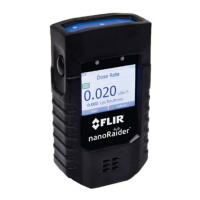FLIR Detection D. Glossary
Nuclear Fusion
ÚFusion
Nucleon
Collective name for ÚNeutrons and ÚProtons, two subatomic particles building an atomic
ÚNucleus.
Nucleon Number
ÚMass Number
Nucleus
The nucleus is a component of an ÚAtom, carrying the majority of the net mass and an electric
charge that is equal to the charge of all ÚElectrons that orbit the nucleus. A nucleus consists
of ÚNeutrons and ÚProtons, which are therefore also called ÚNucleons.
Nuclide
A nuclide is a ÚNucleus with a speciied number of protons and neutrons, that is, having spe-
ciic nuclear properties.
Nuclides are speciied by the name of the chemical ÚElement which implies the ÚAtomic
Number and the ÚMass Number, for example,
40
18
Ar or
40
19
K. Where sub- and superscripting
are not possible or too challenging, nuclides are often written as Ar-40 or K-40.
OBEX
ÚOBject EXchange
OBject EXchange (OBEX)
A communications protocol for the exchange of binary objects between devices. It is main-
tained by the Infrared Data Association but has also been adopted by the Bluetooth Special
Interest Group and the SyncML wing of the Open Mobile Alliance.
Also known as: IrOBEX
Pairing
A mechanism to establish a trusted connection between two devices communicating via Blue-
tooth requiring user interaction only during the irst connection of two particular devices.
PAN ÚPersonal Area Networking
Particle Radiation
A type of ÚRadiation, whose emission components carry a inite rest mass. ÚAlpha Radiation
and ÚBeta Radiation are examples for Particle Radiation.
PE ÚPolyethylene
Peak The place where a function or a measurement (or a graphic rendering thereof) is higher than
in the close vicinity (Figure 242, p. 274).
Also known as: Local Maximum
identiFINDER
®
R300/en/2014.4(13623)/Feb2015 281

